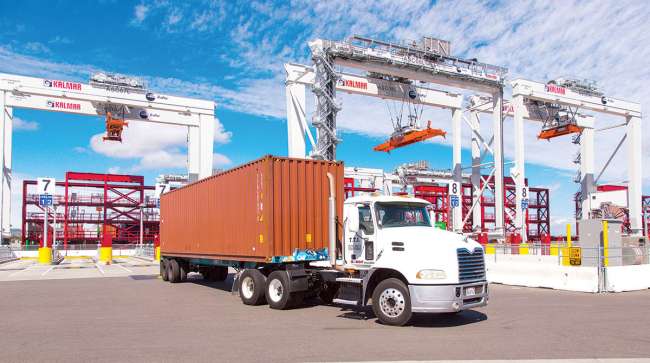Senior Reporter
Bill Would Let Younger Drivers Move Freight at Ports

[Stay on top of transportation news: Get TTNews in your inbox.]
Legislation that aims to allow young commercial drivers to transport freight from ports was recently introduced in the U.S. House of Representatives.
Led by Rep. Brian Mast (R-Fla.), the Ceasing Age-Based (CAB) Trucking Restrictions Act would classify certain statewide freight operations linked to ports as in-state matters.
“For the better part of two years, families have struggled to get the goods they need, from baby formula to toilet paper, and Joe Biden has failed to fix it,” Mast said in a statement Jan. 10 that accompanied the bill’s introduction.
“House Republicans are ready to get to work and deliver for the American people,” added Mast, a member of the Transportation and Infrastructure Committee. “The first bill I am introducing this Congress keeps our promise to fix the supply chain by cutting through red tape that keeps qualified drivers off the road.”
America’s supply chain is in crisis, and our businesses need relief. Proud to co-sponsor @RepBrianMast’s CABs Act to remove bureaucratic and burdensome regulations placed on the trucking industry and get our supply chain moving. https://t.co/sajYGKvI0U — Rep. Burgess Owens (@RepBurgessOwens) January 12, 2023
Truckers who are 18 to 20 years old are allowed to drive commercial vehicles in intrastate commerce in nearly every state and the District of Columbia. However, these drivers are prohibited from transporting freight originating from U.S. ports of entry. Such ports are considered interstate commerce. Changing that classification at ports would pave the way for truck drivers 18 to 20 years old to transport freight from these facilities.
Sponsors of the bill include Republican Reps. Scott Perry of Pennsylvania, Ashley Hinson of Iowa and Burgess Owens of Utah.
“America’s supply chain is in crisis,” Owens said shortly after the bill’s introduction. He is a member of the transportation panel. “Struggling businesses in Utah and across the nation require immediate action to ease these harmful disruptions and rebound from key product shortages.”

Mast
Other Republican sponsors of the bill include Reps. Tom McClintock of California, Michael Guest of Mississippi and Randy Feenstra of Iowa.
“From food and fuel to furniture and fertilizer, Iowa truckers work overtime to keep our shelves stocked and our supply chains moving. However, federal over-regulation has exacerbated trucker shortages and prevented household goods that our families rely on from reaching market,” said Feenstra, a member of the Budget Committee, in a separate statement.
“I’m proud to help introduce common-sense legislation to eliminate bureaucratic red tape, streamline our supply chains, and ensure that qualified, safe drivers can more efficiently transport everyday goods,” the congressman continued.
This year, House Transportation Committee Chairman Sam Graves (R-Mo.) has expressed a willingness to pursue efforts that ameliorate supply chain connectivity. “I look forward to working with all members of the committee as we aim to develop solutions to improve our infrastructure, strengthen transportation programs, and help alleviate ongoing energy and supply chain problems,” as the chairman put it.

Host Seth Clevenger speaks with Torc Robotics CEO Peter Vaughan Schmidt about the realities of autonomous truck technology and how they fit into the freight transportation industry. Hear the program above and at RoadSigns.TTNews.com.
Second of a three-part series on autonomous vehicles. Hear Part I here. Part III coming Feb. 2.
The CAB Trucking Restrictions Act, while specific to ports, would expedite ongoing efforts to turn to a young driver workforce for supply chain operations. The enactment of a $1.2 trillion infrastructure law created the Safe Driver Apprenticeship Pilot Program to train truckers under 21 years old on interstate functions. The apprenticeship is meant to help young truck drivers connect with interstate trucking careers, according to the Federal Motor Carrier Safety Administration.
The Biden administration has emphasized that an influx of funding resulting from the Infrastructure Investment and Jobs Act would ideally enhance safety along freight corridors, as well as connectivity at commercial supply chains. The bipartisan infrastructure law was enacted in 2021.
“We’re doing everything that we can to improve the careers in the professions that power our supply chain,” Secretary of Transportation Pete Buttigieg said last month.
For emphasis, the secretary added: “We’re building new truck parking, so that drivers can get safe rest. We’ve launched the Women of Trucking Advisory Board, because we can’t leave half of America’s talent on the table and miss out on a generation of great drivers because women aren’t supported in the career. We’re investing to help my fellow veterans get opportunities to enter the transportation workforce debt-free.”
Want more news? Listen to today's daily briefing above or go here for more info
American Trucking Associations recently determined the industry is short approximately 78,000 drivers. That is down slightly from the previous estimate of 80,000 drivers.
Bill Sullivan, ATA executive vice president of advocacy, commended Mast’s bill. “As America and the world learned in recent years, our economy is held together by trucks. Widening and deepening the pool of talent to drive those trucks is vital to addressing economic growth, mitigating inflation and ensuring delivery of our nation’s freight.”
Jonathan Eisen, executive director of ATA Intermodal Motor Carriers Conference, added: “The inability of the intermodal supply chain to handle the volume of imported freight that we saw for much of the last two years has had long-term impacts that our economy is still struggling with.”
“The Intermodal Motor Carriers Conference believes this legislation permitting all CDL drivers to carry freight from our nation’s ports to destinations within the same state will help increase the pool of available drivers to avoid a replay of this situation when elevated freight levels return,” Eisen added.




